Welcome to Aylesbury
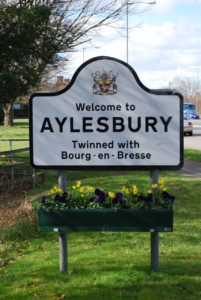
Aylesbury, the County Town of Buckinghamshire, is a bustling market town which is confidently moving forward in the 21st century. Its origins, however, are of great antiquity. The name ‘Aylesbury’ is thought to be a derivative of ‘Aigle’s Burgh’ meaning hill town or fort. Excavations in 1985 on a site adjacent to Nelsons Terrace and Oxford Road in Aylesbury old town found the remains of an Iron Age hillfort dating back to 650 BC.
The Romans built Akeman Street, which runs through Aylesbury Vale as the A41. It was part of their great road network in Britain, created initially for moving troops and equipment rapidly from one base to another. It ran for 78 miles from Verulamium (St Albans) to Corinium (Cirencester). Later this military convenience served to facilitate the rapid growth of Romano-British trade and commerce. The Romans left Saxon mercenaries guarding Akeman Street, and the remains of a Roman-British settlement from the 1st/2nd Century were found in 1979 in Buckingham Street where Sainsbury’s store now stands.
In 571, Cuthwulf and his army of Anglo-Saxons drove the resident Celtic Britons out of the area. Later the Danes came, ousted the Anglo-Saxons and settled in their place, but they in turn were overrun in the 10th century by Edward the Confessor’s troops. About 90 years of instability then followed and the area was not pacified until after the Norman conquest of 1066.
Aylesbury was given its charter and borough status in 1554 by a grateful Mary Tudor, in appreciation of the town’s loyalty in declaring her Queen of England against the competing claims of Lady Jane Grey.
During the English Civil War Aylesbury at times took centre-stage. At the Battle of Holman’s Bridge in 1642 the defence of Aylesbury was led by John Hampden, cousin to Oliver Cromwell. As an MP, John had opposed Charles I on the Ship Money issue, refusing to pay the tax which was being levied to underwrite an expansion of the Royal Navy. A bronze statue at the top of Market Square commemorates his contribution to the Parliamentary cause. Another radical MP for Aylesbury was John Wilkes, who, spent time in the Tower of London during the 18th century, accused of seditious libel.
In the early 18th century Aylesbury gradually assumed the role of County Town from Buckingham. Buckingham is a long way from the south of the county and Aylesbury slowly replaced it as the centre of administration. The Summer Assizes and the law courts moved here in 1707 and this took much trade away from Buckingham. In 1725 a terrible fire in Buckingham destroyed much of the town centre and made more than 500 people homeless. This confirmed Aylesbury as the centre of government for the County and thus began a period of building numerous civic buildings.
During the 19th century, Aylesbury developed links with transport networks connecting other parts of the country. The Aylesbury Branch of the Grand Union Canal was opened in 1814 and is thought to have been used as a staging post in the transportation of slaves, before slavery was abolished. In 1839 Aylesbury was the first place in the world to have its own railway branch line. The Great Western Railway built a branch line from Princes Risborough in 1863 and The Metropolitan Railway arrived in 1892. A connection to Buckingham was completed in 1868 and in 1899 Aylesbury was finally on a main line from London to Manchester when the Great Central Railway arrived.
The town grew very slowly from mediaeval times until the beginning of the 19th century when the population of Britain started to increase generally. The 1811 census showed that the population of Aylesbury was 3,447; the 1841 census recorded 5,414 residents and in 1901 it was 9,243. The number of townspeople increased steadily until the 1960s, when Aylesbury was selected as an overspill town for Londoners and a massive housing expansion took place. At the same time, the centre of Aylesbury was extensively renovated and modernised. By 1995 the population had increased to about 60,000. This has risen to roughly 65,000 in 2008 but is expected to reach 100,000 over the next 20 years. The 2021 census stated the population is 87,135.
Aylesbury Old Town
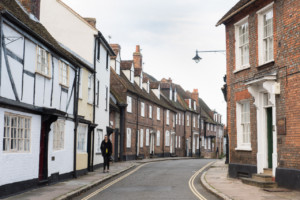
Most of the older buildings in Aylesbury are to be found in the streets surrounding Market Square, St Mary’s Square, Kingsbury and Church Street. Predominantly Georgian in character, with some small Tudor and Jacobean enclaves, the Old Town is home to the Kings Head coaching Inn, Discover Bucks Museum with the Roald Dahl Children’s Gallery, and 18th century Prebendal House, once the residence of firebrand MP John Wilkes.
The Market Square has lost most of its historic buildings but still has paved footpaths and stone setts. It also has at its centre the Clock Tower, completed in 1877 and thought to stand on or close to the site of the original guildhall of Aylesbury. The rich and fertile loam of the Vale of Aylesbury was perfect for farming and husbandry and from 1204 until the end of the 20th century there was a twice-weekly sheep, pig and cattle market in the square. The many ponds and waterways in the Vale supported the development of the then local speciality, the Aylesbury Duck. The duck, pure white, with a flesh coloured beak and bright orange legs and feet, was valued by chefs and bon-viveurs for the richness of its flavour.
Old established family shops surrounded the square in the 18th and 19th centuries. For example Augustus Lines, the grocery and tea emporium, offered “Teas genuine as imported by the Honourable East India Company” and other commodities such as vinegar, hops, local bacon, spices, fruits etc. It was also possible to purchase chandlery, haberdashery, drapery and saddlery in the market place.
The Crown Courts stand at the bottom of the Market Square. Malefactors (and possibly also the innocent) sentenced to be hanged were once publicly executed from a balcony on the front of the Court House. Spectators used to pay for a place on the balcony of the Green Man Inn (now The Square) to get the best view.
The recumbent lions in front of the Courts were given by Baron Ferdinand de Rothschild of Waddesdon Manor in 1888.
At the top of Market Square and through a linking thoroughfare is Kingsbury. Many Kingsbury properties have interesting histories. For example no. 27, now Meat N Eat, was formerly home to Ivatts Boot & Shoemakers. Seven generations of this family traded here over a period of 225 years. A member of the Ivatts family features in the painting ‘The Jury’ by John Morgan. Morgan used Aylesbury burghers as models for his jury. The picture was purchased by the County Museum (now Discover Bucks Museum), to ensure that it returned to Aylesbury, and now has pride of place in the Art Gallery.
The King’s Head
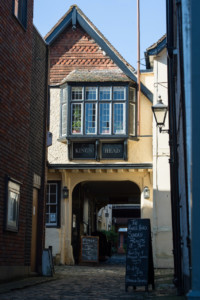
Of great interest to visitors is the 14th century Kings Head, set back from the Market Square and reached via a narrow, cobbled passageway. The building, originally the guesthouse of a monastery, has been an inn since the 15th century. The archway wide enough for coaches to pass through, leads to a picturesque cobbled stable yard. A section of wall in the inn has been exposed to demonstrate its ‘wattle and daub’ construction.
An outstanding feature of this ancient inn is its great Tudor window, with 20 lights. The large, wooden framed window with mullions and transoms contains fragments of 15th century glass. The ancient glass is illustrated with heraldic devices such as angels carrying shields, on which are emblazoned the coats of arms of Prince Edward, killed at the battle of Tewkesbury, and scenes commemorating the marriage of Henry VI and his Queen, Margaret of Anjou in 1445. The King and his bride are believed to have stayed at the Kings Head during their honeymoon.
Other famous historic guests at the inn include Henry VIII, and ‘Hanging’ Judge Jeffries. The Lord Protector, Oliver Cromwell stayed at the inn after the battle of Worcester in 1651. The chair used by Cromwell can still be seen at the inn.
The bar of the inn was once the great hall of the medieval manor house of Aylesbury, which occupied the North side of the Market Square.
Now the property of the National Trust, visitors can enjoy a pint of real ale and good food or simply soak up the sun in the Medieval courtyard.
St Mary’s Church
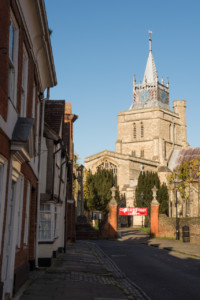
From the Kings Head it is but a stone’s throw to Church Street and the Parish Church of St Mary’s.
There is believed to have been a church on this site since the 12th century. It is thought that extensive rebuilding in the 13th century gave rise to the cruciform shape of the present edifice. Regular extensions were added through the 14th and 15th century and most of the building was re-roofed.
Relics of the early structure still exist. These include the 12th century font, which has been widely copied and its style is now known as the ‘Aylesbury Font,’ and the 15th century perpendicular West Window. This window depicts colourful characters and places from the Old Testament. Additionally there is an effigy of a knight in armour with a lion couchant, and a memorial to Lady Lee, wife of Sir Henry Lee QC, the personal Champion of Queen Elizabeth I.
By the 19th century, however, the foundations of St Mary’s were failing and the whole structure was in a dangerous condition. It was completely restored in 1850 by Sir Gilbert Scott, who created the current rough-coursed construction with ashlar enhancements.
The modern church houses a very generously proportioned knave which was extensively renovated through the efforts of the Bucks Battalion of the County Regiment as a memorial to the fallen of World Wars I and II.
Outside the Church, at the corner of Church Street and the narrow stone passage to Pebble Lane, stand the former St Mary’s Church halls. Once part of Aylesbury Grammar School, they and the adjoining buildings of Ceely House, were for a time private dwellings but now accommodate the County Museum and Art Gallery. The old Coach House at the rear of Ceely House contains the famous and perennially popular Roald Dahl Children’s Gallery. For more information and opening times telephone 01296 331441, click here to send an email or click here to visit the Discover Bucks Museum website.
The third arm of the junction formed by Church Street and Pebble Lane is Parsons Fee, a charming thoroughfare of timber-framed cottages. Just beyond the Parish Church in Parson’s Fee is Prebendal House. Prebendal House was the home of John Wilkes for a number of years from about 1746. The Radical became MP for Aylesbury in 1757 and involved himself in many local worthy and charitable causes. However, he was also associated with Sir Francis Dashwood of West Wycombe and the infamous Medmenham Monks of the Hell Fire Club. Wilkes was a man with a wicked sense of humour. It is said that during one extremely bacchanalian orgy Wilkes introduced a large baboon dressed as Beelzebub, and frightened the ‘monks’, who were enacting a satanic ritual, half to death.
Wilkes founded a weekly pamphlet called the ‘North Briton’ and a number of its issues attacked King George III and prominent members of his administration. In 1763 after a particularly inflammatory issue Wilkes was thrown into the Tower of London, before being released on Parliamentary privilege. Another arrest in 1768 brought 15,000 people out onto the streets of London and precipitated the famous “Wilkes and Liberty” marches. He is remembered today as a defender of freedom of speech and personal liberty.
Next to Prebendal House in Parson’s Fee stands St Osyths, a charming timber framed building named after the Saxon saint who is reputed to have performed miracles in Aylesbury.
Hartwell House, between Aylesbury and Stone, once harboured the exiled King Louis XVIII of France, and this fact is commemorated in the name of Bourbon Street which is the edge of the old town.
Aylesbury Town today
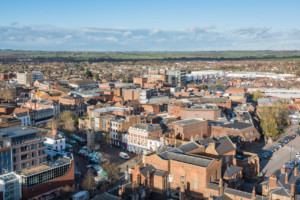
During the 1950s and 60s, thousands of new homes were constructed in Aylesbury to relocate Londoners. This was followed by extensive redevelopment of the Town centre. Some Aylesbury residents regretted the demolition of ancient buildings and the loss of old street patterns, but others welcomed the growth and investment.
Friars Square shopping centre was opened in 1967 to provide much-needed functional modern retail units, to meet the demands of the growing population. Originally the market relocated to the new centre but in 1990 Friars Square was demolished and refurbished into a modern indoor shopping mall and the market moved back to its natural home in the Market Square. Hale Leys indoor shopping mall was opened by Diana Princess of Wales in 1981.
The increasingly complex administration requirements of the County were given much-needed accommodation in the 12 storey County Hall, opened in 1966. Designed by F.B.Pooley, the County Architect at the time, the building heralded a brand new age for the then sleepy market town of Aylesbury. The new building formed an integral part of the new development of the town and was eventually linked to the new Friars Square and bus station. It replaced some fine Regency houses in Walton Street and together with Friars Square which was opened a year later in 1967, replaced the quaint but run down shopping areas of Silver Street, Great Western Street and the old Friarage Road. At the time, The Bucks Herald ran a special six page supplement and in it Fred Pooley, the County Architect, commented that “most new buildings which have represented an advance in architecture have had to bear a great deal of criticism and I accept that as a piece of architecture [the county offices] will be judged by history either as a miserable failure or as a building which made a contribution to the development of world architecture”. It is fair to say that no other building in Aylesbury has had such a love/hate relationship with the people of the town and 42 years on, it continues to be controversial.
At about the same time a programme of road widening and improvement produced the inner ring road which still helps to keep traffic flowing smoothly in the Town. A dual carriageway link to the M25 was completed in 1996.
Close to County Hall stands one of the most remarkable buildings in Aylesbury. This is the ‘Blue Leanie’ a glass and brick edifice with slanting walls. The ‘Blue Leanie’ was constructed in 1982 originally to house the headquarters of the Equitable Life Company. Now it is the Aylesbury home of Halifax Bank of Scotland, or HBoS. Also in Walton Street are some other striking new buildings. Millennium House is home to the software company ESRI and next door is The Observatory an example of the many flats and apartments that have been built in Aylesbury. Additionally 400 homes next to the station have been completed and the prestigious development of 130 flats and apartments has been built on the former Nestles factory site close to the town centre.
Aylesbury Vale is the fourth fastest growing local authority in the south east of England. It has grown rapidly in recent years mainly as a result of the increase of housing in the district. On average 750 new houses are completed each year. When the Government decided that Aylesbury Vale should be a major area for further growth in the south east it stipulated that the larger Aylesbury Vale must be built through a sustainable development programme thus planning not simply more houses but also new jobs, improved infrastructure and a protected and enhanced environment.
New developments in Aylesbury Vale will be concentrated in the town near existing services and its retail centre. Approximately 18,300 new houses have recently been built with five out of every six being in Aylesbury. On the town’s periphery the major development areas of Weedon Hill provides 850 homes and Berryfields provides 3,000 homes.
The Office of the Deputy Prime Minister has supported three major investment schemes in the town. It is planned to develop a major new business park, on the Aston Clinton Road, drawing tenants from across the region. The development will consist of a business park including office buildings, 125 dwellings, hotel and gym, mixed use core comprising, retail, cafe and up to 25 dwellings, public open space, new access, roads and services. The Waterside development which will provide new shops, pubs, restaurants, a theatre and additional houses is being complemented in Walton Street by a new 500 space car park, an Ex Serviceman’s club and 240 new residential apartments.

